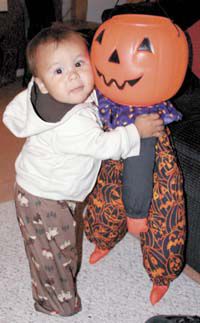| 13 month old Halton Hunt is ready to trick-or-treat on Oct. 31. |
Dark costumes and speeding motorists can represent a dangerous combination on Halloween.
To alleviate potential risks, Price Police Capt. Kevin Drolc indicated that local law enforcement agencies remind Carbon County residents to take steps to ensure the safety of children celebrating the fall holiday.
“Drivers being careful and looking out for small children darting out in front of their vehicle is our number one concern every year,” said Drolc. “However, to aid drivers I would also encourage parents to make sure their children wear safe costumes with masks that are reflective and easy to see.”
According to the Price police captain, the city will enforce its normal curfew on Oct. 31, which falls on a Wednesday.
“Our city curfew states that all children under the age of 16 must be in before 10 p.m. and all those between the ages of 16 and 18 must be off the street before 11 p.m. unless they are accompanied by an adult,” said Drolc. “For younger kids, it is my opinion that children under the age of 12 should be supervised by an adult during their trick or treat activities.”
The National Safety Council has identified several issues as the keys to safely observing the holiday.
•Motorists should:
Watch for children darting out from between parked cars.
Watch for children walking on roadways, medians and curbs.
Enter and exit driveways, alleys and side streets carefully.
At twilight and later in the evening, drivers should watch for children in dark clothing.
•Carbon County residents should:
Make certain that an adult or an older responsible youth will be supervising the outing for children younger than 12 years of age.
Plan and discuss the route trick-or-treaters intend to follow.
Know the names of older children’s companions.
Instruct youth to travel only in familiar areas and along an established route.
Teach children to stop only at houses or apartment buildings that are well lit and never to enter a stranger’s home.
Make sure first-time teenage drivers are aware of the dangers associated with Halloween.
Establish a return time.
Tell youngsters not to eat any treat until they return home.
Review all appropriate trick-or-treat safety precautions, including pedestrian and traffic safety rules.
Pin a slip of paper with the child’s name, address and phone number inside a pocket in case the youngster gets separated from the group.
•Costume design:
Only fire retardant materials should be used for costumes.
Costumes should be loose so warm clothes can be worn underneath.
Costumes should not be so long that they are a tripping hazard. Falls are the leading cause of unintentional injuries on Halloween.
If children are allowed to venture out into neighborhoods after dark, the Halloween outfits should be constructed with light colored materials.
Strips of retro-reflective tape should be used to make children visible.
•Face design:
Masks can obstruct a child’s vision.
To remedy the situation, parents and guardians should have youth apply facial make-up instead of wearing Halloween masks.
When buying Halloween makeup, people should check for packages containing ingredients that are labeled “made with U.S. approved color additives,” “laboratory tested” or “meets federal standards for cosmetics.”
Masks should have nose and mouth openings as well as large eyes.
•Treats:
Adults should have children eat an early meal before youngsters go out on Halloween.
People should insist that treats be brought home for inspection by adults in the household before anything is eaten by children.
Fruit should be washed and slice into small pieces.
When in doubt, parents should throw the Halloween treats away.
The safety council calls Halloween a cherished tradition, but warns that the excitement of the night can cause children to forget caution.
“There is no trick to safety,” concluded Drolc. “If parents, teenagers and children are careful Halloween is a great time in our community.”

